Abstract
1. The effects of SD-3212 on transmembrane action potentials were examined in right ventricular papillary muscles and in single ventricular myocytes isolated from guinea-pig hearts. 2. In papillary muscles, SD-3212 > or = 3 microM caused a significant decrease in the maximum upstroke velocity (Vmax) of action potential without affecting resting membrane potential. The inhibition of Vmax was enhanced at higher stimulation frequencies. 3. In the presence of SD-3212, trains of stimuli at rates > or = 0.5 Hz led to a use-dependent inhibition of Vmax. The time constant for the recovery of Vmax from the use-dependent block was 1.3 s. 4. Voltage-dependence of Vmax inhibition by SD-3212 was investigated in single myocytes. The curves relating membrane potential and Vmax were shifted by SD-3212 (10 microM) in a hyperpolarizing direction by 6.2 mV. 5. In myocytes treated with SD-3212 (10 microM), the Vmax of test action potentials preceded by conditioning clamp to 0 mV was decreased progressively as the clamp pulse duration was prolonged. Vmax of test action potentials following a long (1 s) 0 mV clamp recovered at a time constant ranging from 1.01 to 1.22 s, being shorter at the more negative potential within a range from -70 to -90 mV. 6. These findings suggest that the primary electrophysiological effect of SD-3212 is a use- and voltage-dependent inhibition of sodium channels. From the onset and offset kinetics of the use-dependent block, SD-3212 is located between fast and intermediate kinetic Class-I drugs.(ABSTRACT TRUNCATED AT 250 WORDS)
Full text
PDF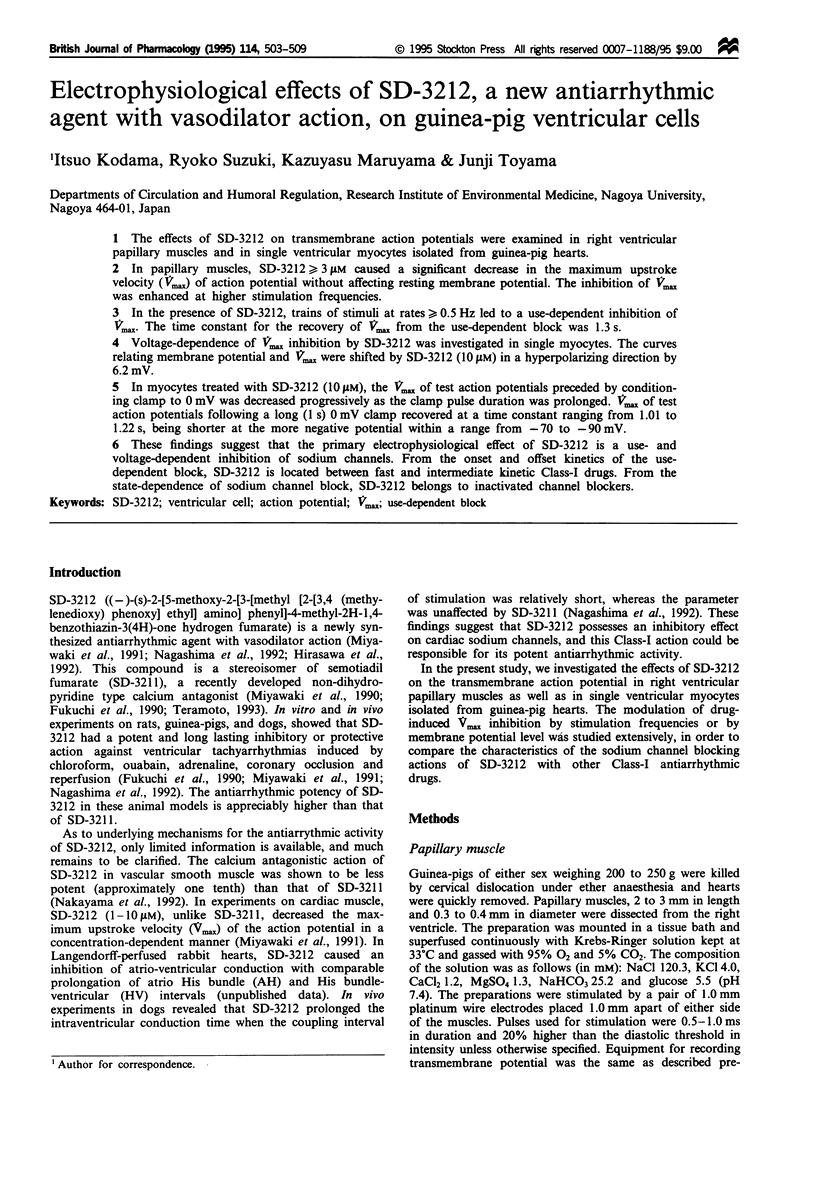

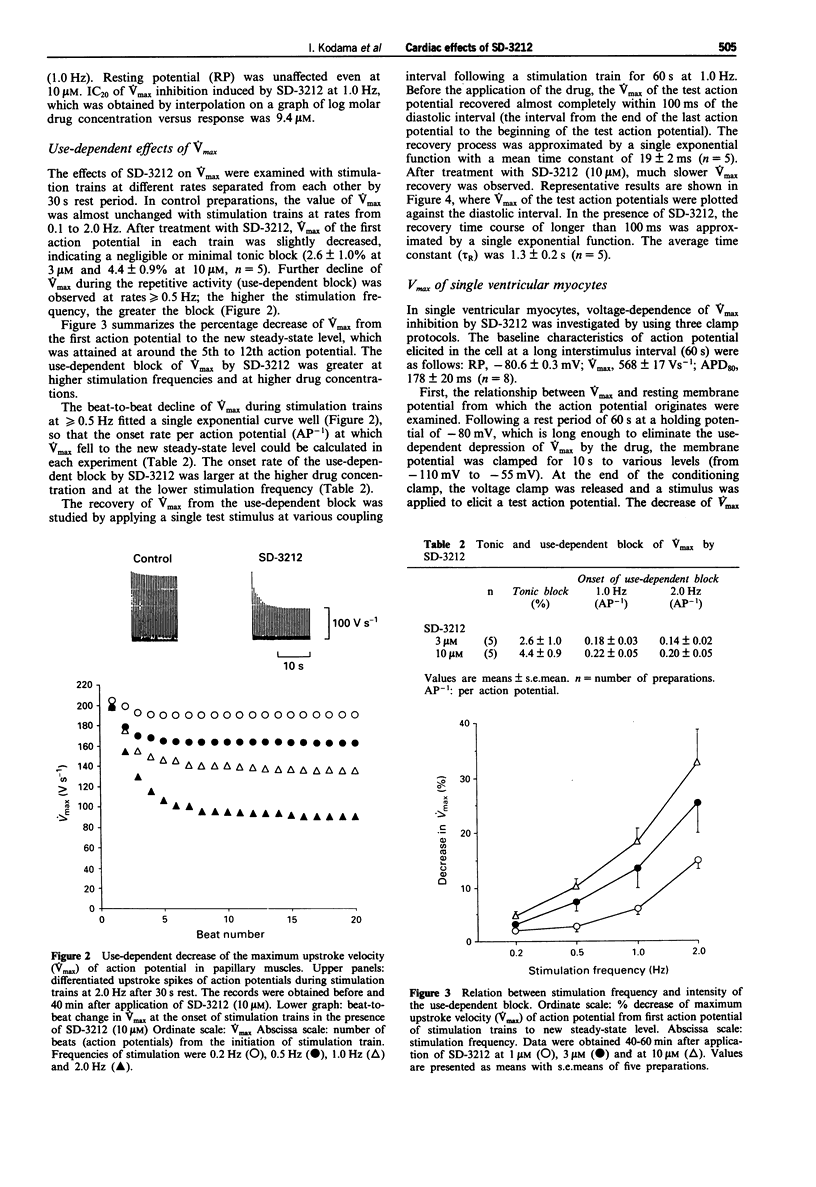
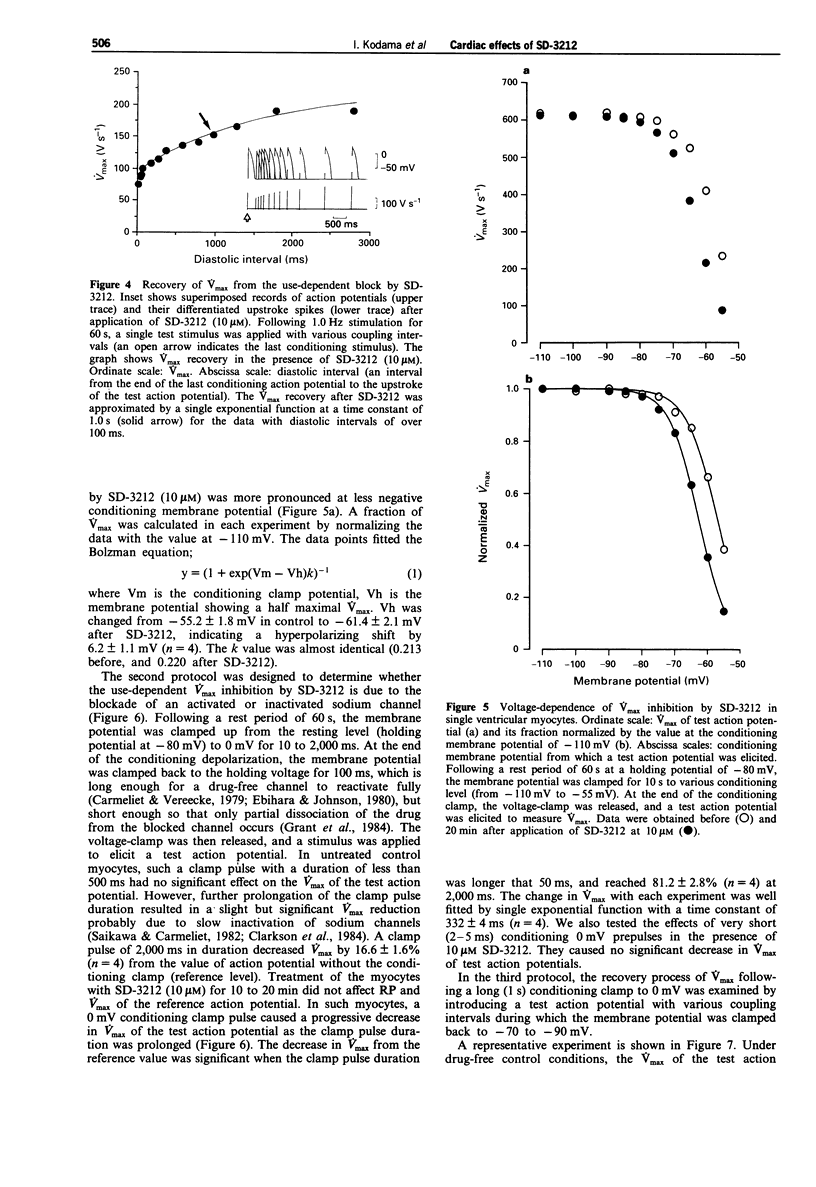
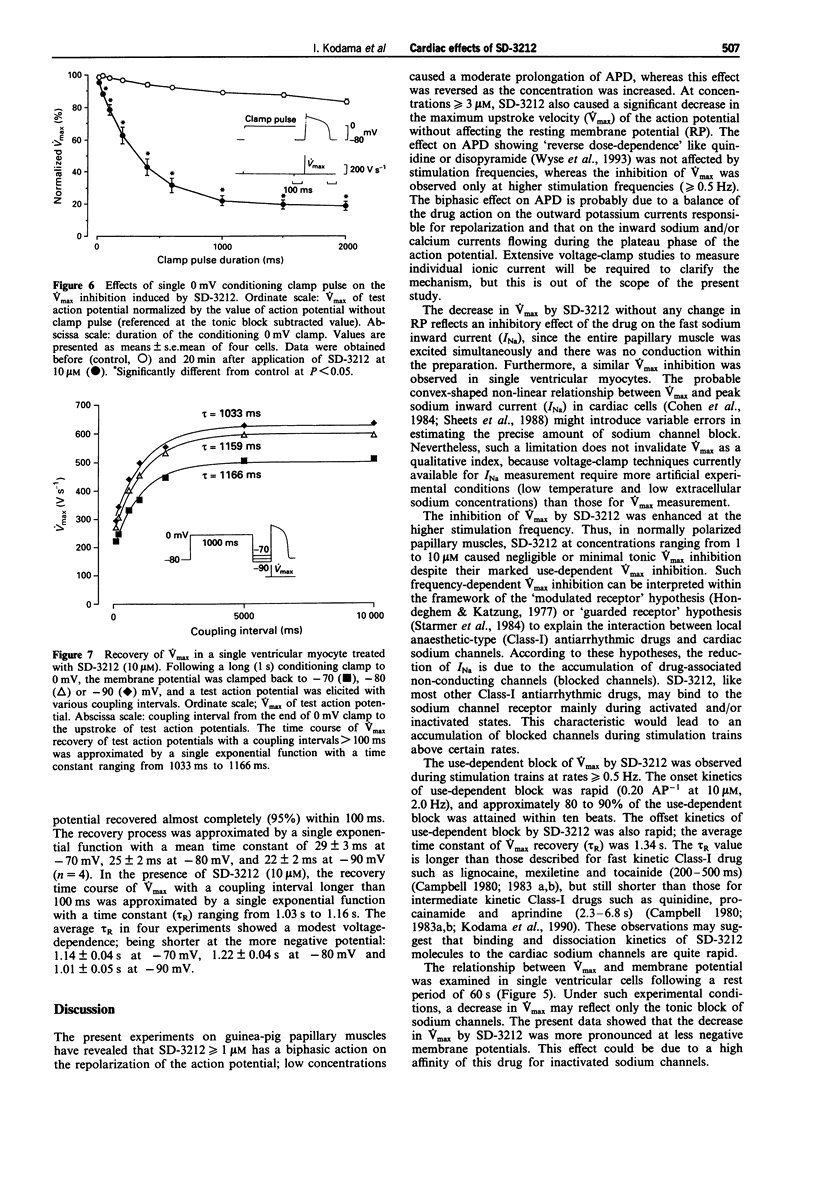
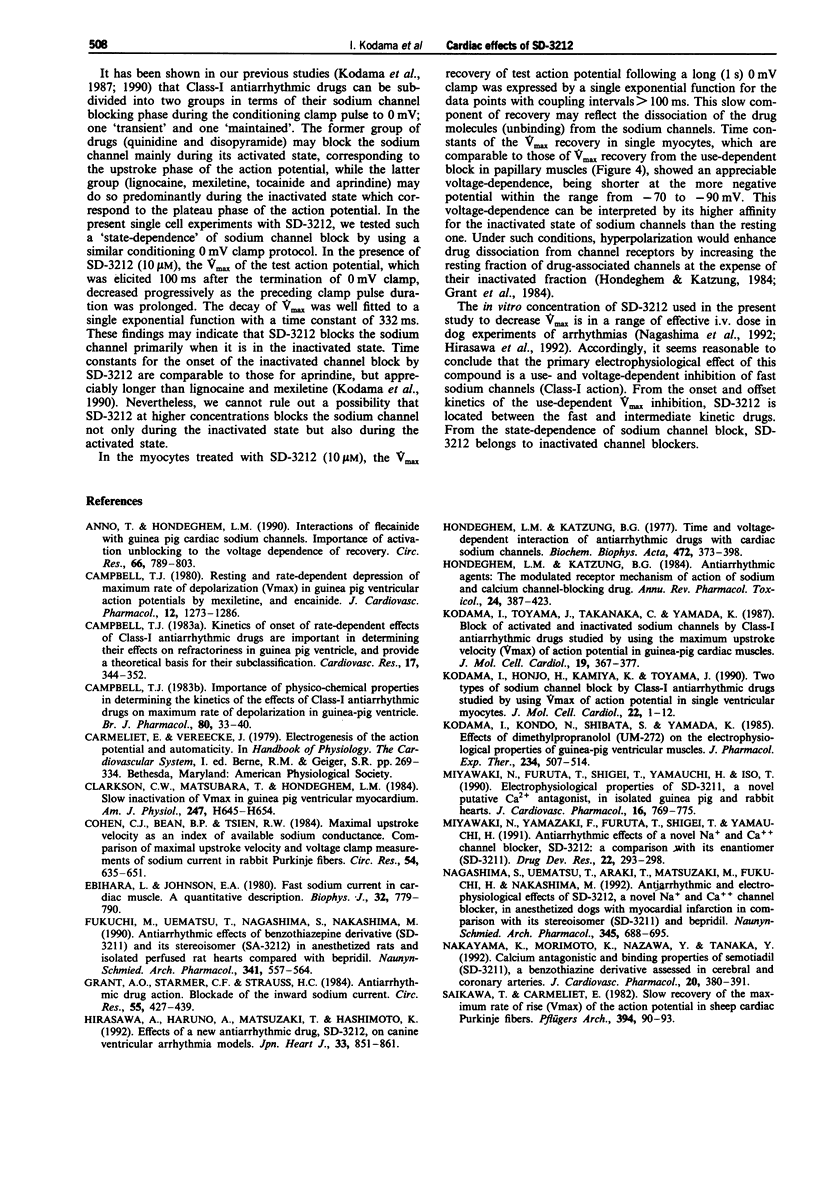

Selected References
These references are in PubMed. This may not be the complete list of references from this article.
- Anno T., Hondeghem L. M. Interactions of flecainide with guinea pig cardiac sodium channels. Importance of activation unblocking to the voltage dependence of recovery. Circ Res. 1990 Mar;66(3):789–803. doi: 10.1161/01.res.66.3.789. [DOI] [PubMed] [Google Scholar]
- Campbell T. J. Importance of physico-chemical properties in determining the kinetics of the effects of Class I antiarrhythmic drugs on maximum rate of depolarization in guinea-pig ventricle. Br J Pharmacol. 1983 Sep;80(1):33–40. doi: 10.1111/j.1476-5381.1983.tb11046.x. [DOI] [PMC free article] [PubMed] [Google Scholar]
- Campbell T. J. Kinetics of onset of rate-dependent effects of Class I antiarrhythmic drugs are important in determining their effects on refractoriness in guinea-pig ventricle, and provide a theoretical basis for their subclassification. Cardiovasc Res. 1983 Jun;17(6):344–352. doi: 10.1093/cvr/17.6.344. [DOI] [PubMed] [Google Scholar]
- Clarkson C. W., Matsubara T., Hondeghem L. M. Slow inactivation of Vmax in guinea pig ventricular myocardium. Am J Physiol. 1984 Oct;247(4 Pt 2):H645–H654. doi: 10.1152/ajpheart.1984.247.4.H645. [DOI] [PubMed] [Google Scholar]
- Cohen C. J., Bean B. P., Tsien R. W. Maximal upstroke velocity as an index of available sodium conductance. Comparison of maximal upstroke velocity and voltage clamp measurements of sodium current in rabbit Purkinje fibers. Circ Res. 1984 Jun;54(6):636–651. doi: 10.1161/01.res.54.6.636. [DOI] [PubMed] [Google Scholar]
- Ebihara L., Johnson E. A. Fast sodium current in cardiac muscle. A quantitative description. Biophys J. 1980 Nov;32(2):779–790. doi: 10.1016/S0006-3495(80)85016-8. [DOI] [PMC free article] [PubMed] [Google Scholar]
- Fukuchi M., Uematsu T., Nagashima S., Nakashima M. Antiarrhythmic effects of a benzothiazine derivative (SD-3211) and its stereoisomer (SA3212) in anaesthetized rats and isolated perfused rat hearts compared with bepridil. Naunyn Schmiedebergs Arch Pharmacol. 1990 Jun;341(6):557–564. doi: 10.1007/BF00171737. [DOI] [PubMed] [Google Scholar]
- Grant A. O., Starmer C. F., Strauss H. C. Antiarrhythmic drug action. Blockade of the inward sodium current. Circ Res. 1984 Oct;55(4):427–439. doi: 10.1161/01.res.55.4.427. [DOI] [PubMed] [Google Scholar]
- Hirasawa A., Haruno A., Matsuzaki T., Hashimoto K. Effects of a new antiarrhythmic drug, SD-3212, on canine ventricular arrhythmia models. Jpn Heart J. 1992 Nov;33(6):851–861. doi: 10.1536/ihj.33.851. [DOI] [PubMed] [Google Scholar]
- Hondeghem L. M., Katzung B. G. Antiarrhythmic agents: the modulated receptor mechanism of action of sodium and calcium channel-blocking drugs. Annu Rev Pharmacol Toxicol. 1984;24:387–423. doi: 10.1146/annurev.pa.24.040184.002131. [DOI] [PubMed] [Google Scholar]
- Hondeghem L. M., Katzung B. G. Time- and voltage-dependent interactions of antiarrhythmic drugs with cardiac sodium channels. Biochim Biophys Acta. 1977 Nov 14;472(3-4):373–398. doi: 10.1016/0304-4157(77)90003-x. [DOI] [PubMed] [Google Scholar]
- Kodama I., Honjo H., Kamiya K., Toyama J. Two types of sodium channel block by class-I antiarrhythmic drugs studied by using Vmax of action potential in single ventricular myocytes. J Mol Cell Cardiol. 1990 Jan;22(1):1–12. doi: 10.1016/0022-2828(90)90967-7. [DOI] [PubMed] [Google Scholar]
- Kodama I., Kondo N., Shibata S., Yamada K. Effects of dimethylpropranolol (UM-272) on the electrophysiological properties of guinea-pig ventricular muscles. J Pharmacol Exp Ther. 1985 Aug;234(2):507–514. [PubMed] [Google Scholar]
- Kodama I., Toyama J., Takanaka C., Yamada K. Block of activated and inactivated sodium channels by class-I antiarrhythmic drugs studied by using the maximum upstroke velocity (Vmax) of action potential in guinea-pig cardiac muscles. J Mol Cell Cardiol. 1987 Apr;19(4):367–377. doi: 10.1016/s0022-2828(87)80582-5. [DOI] [PubMed] [Google Scholar]
- Miyawaki N., Furuta T., Shigei T., Yamauchi H., Iso T. Electrophysiological properties of SD-3211, a novel putative Ca2+ antagonist, in isolated guinea pig and rabbit hearts. J Cardiovasc Pharmacol. 1990 Nov;16(5):769–775. doi: 10.1097/00005344-199011000-00012. [DOI] [PubMed] [Google Scholar]
- Nagashima S., Uematsu T., Araki S., Matsuzaki T., Fukuchi M., Hashimoto H., Nakashima M. Antiarrhythmic and electrophysiological effects of SD-3212, a novel Na+ and Ca++ channel blocker, in anaesthetized dogs with myocardial infarction in comparison with its stereoisomer (SD-3211) and bepridil. Naunyn Schmiedebergs Arch Pharmacol. 1992 Jun;345(6):688–695. doi: 10.1007/BF00164584. [DOI] [PubMed] [Google Scholar]
- Nakayama K., Morimoto K., Nozawa Y., Tanaka Y. Calcium antagonistic and binding properties of semotiadil (SD-3211), a benzothiazine derivative assessed in cerebral and coronary arteries. J Cardiovasc Pharmacol. 1992 Sep;20(3):380–391. doi: 10.1097/00005344-199209000-00007. [DOI] [PubMed] [Google Scholar]
- Saikawa T., Carmeliet E. Slow recovery of the maximal rate of rise (Vmax) of the action potential in sheep cardiac Purkinje fibers. Pflugers Arch. 1982 Jul;394(1):90–93. doi: 10.1007/BF01108313. [DOI] [PubMed] [Google Scholar]
- Sheets M. F., Hanck D. A., Fozzard H. A. Nonlinear relation between Vmax and INa in canine cardiac Purkinje cells. Circ Res. 1988 Aug;63(2):386–398. doi: 10.1161/01.res.63.2.386. [DOI] [PubMed] [Google Scholar]
- Starmer C. F., Grant A. O., Strauss H. C. Mechanisms of use-dependent block of sodium channels in excitable membranes by local anesthetics. Biophys J. 1984 Jul;46(1):15–27. doi: 10.1016/S0006-3495(84)83994-6. [DOI] [PMC free article] [PubMed] [Google Scholar]
- Teramoto N. Mechanisms of the inhibitory action of semotiadil fumarate, a novel Ca antagonist, on the voltage-dependent Ca current in smooth muscle cells of the rabbit portal vein. Jpn J Pharmacol. 1993 Mar;61(3):183–195. doi: 10.1254/jjp.61.183. [DOI] [PubMed] [Google Scholar]
- Toyama J., Kamiya K., Kodama I., Yamada K. Frequency- and voltage-dependent effects of aprindine on the upstroke velocity of action potential in guinea pig ventricular muscles. J Cardiovasc Pharmacol. 1987 Feb;9(2):165–172. doi: 10.1097/00005344-198702000-00007. [DOI] [PubMed] [Google Scholar]
- Wyse K. R., Ye V., Campbell T. J. Action potential prolongation exhibits simple dose-dependence for sotalol, but reverse dose-dependence for quinidine and disopyramide: implications for proarrhythmia due to triggered activity. J Cardiovasc Pharmacol. 1993 Feb;21(2):316–322. doi: 10.1097/00005344-199302000-00019. [DOI] [PubMed] [Google Scholar]


